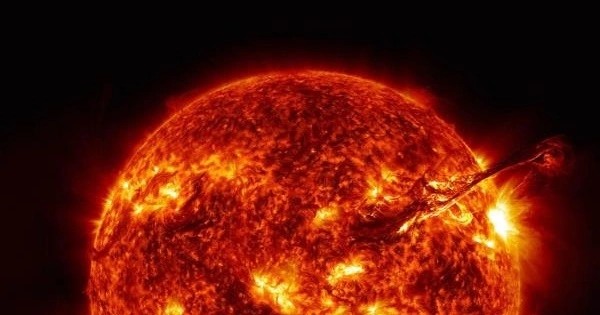A new study provides direct evidence of where near-light speed particle acceleration occurs inside the solar flare, the largest explosion known in the solar system. Solar flares are among the most violent explosions in our solar system, but despite their enormous energy – equivalent to a hundred billion atomic bombs detonating at the same time – physicists have yet to explain how these sudden eruptions on the Sun are able to launch particles to Earth, nearly 93 million miles away, in less than an hour.
Researchers from the New Jersey Institute of Technology (NJIT) have pinpointed the precise location where solar flare charged particles are accelerated to near-light speed in a study published in Nature. The new discoveries were made possible by observations of an X-class solar flare in 2017 by NJIT’s Expanded Owens Valley Solar Array (EOVSA), which revealed a highly efficient particle accelerator located at the tip of the brightest point of the eruption in the Sun’s outer atmosphere, known as the flare’s “cusp region,” where the explosion’s ambient plasma is converted to high-energy electrons.
According to the researchers, the discovery of the region, which is nearly twice the size of Earth, could open up new avenues for studying fundamental processes of particle acceleration that are prevalent throughout the universe.
The findings in this study help explain how solar flares can produce so much energy in mere seconds. The flare’s power is released in a much larger region of the Sun than predicted by the classic model of solar flares.
Gregory Fleishman
“The findings in this study help explain how solar flares can produce so much energy in mere seconds,” said Gregory Fleishman, corresponding author of the paper and distinguished research professor of physics at NJIT’s Center for Solar-Terrestrial Research. “The flare’s power is released in a much larger region of the Sun than predicted by the classic model of solar flares. Although others have speculated that this must occur, this is the first time the precise size, shape, and location of this critical region have been identified, and the efficiency of energy conversion to particle acceleration within the flare has been measured.”
The discovery follows separate studies from 2020 published in Science and Nature Astronomy, where EOVSA’s detailed snapshots of the flare and changes in the Sun’s magnetic field — taken at hundreds of radio frequencies at once — initially gave the NJIT team a lead on the location.
“Our recent studies suggested that the flare cusp could be the location where such high-energy electrons are produced, but we weren’t sure,” said Bin Chen, a NJIT associate professor and paper co-author. “We discovered a magnetic bottle-like structure at the site that contained an overwhelmingly large number of electrons compared to anywhere else in the flare, but now with the new measurements from this study, we can more confidently say this is the flare’s particle accelerator.”
The team was able to measure the energy spectrum of electrons at hundreds of locations of an X-class solar flare triggered by a reconfiguration of magnetic field lines along the Sun’s surface on September 10, 2017 using EOVSA’s unique microwave imaging capabilities.

“The spectral imaging provided by EOVSA provided us with a detailed map of the flare’s thermal plasma as it evolved second by second. But, to our surprise, we discovered a mysterious hole in the thermal plasma map that began to form on the eve of the flare “Gelu Nita, a NJIT research professor and co-author of the paper, agreed. “In addition, as thermal particles in the region vanished, the hole was densely filled with non-thermal, high-energy particles.”
The team’s research revealed an incredibly efficient energy conversion process within the solar flare’s particle accelerator, where intense energy from the Sun’s magnetic fields is rapidly released and converted to kinetic energy within the region.
“We were curious about how efficient this energy conversion process would be… how many particles in this area would be accelerated beyond the thermal energy of the explosion?” said Sijie Yu, study co-author and NJIT assistant research professor. “We confirmed that virtually no particles remained inside the region at thermal energies below a few million Kelvin, consistent with the EOVSA measurement that the particles had all been accelerated to non-thermal energies greater than 20 keV, or nearly 100 million Kelvin,” the researchers wrote.
The team now says these latest findings could help scientists study fundamental questions in particle physics not possible on Earth, as well as offer fresh insights into how such high-energy particles from the Sun may impact Earth during future space weather events.
“A critical aspect of this study is that it directs theorists’ attention to the precise location where the majority of the energy release and particle acceleration occurs, and provides quantitative measurements to guide numerical models,” says Dale Gary, NJIT distinguished professor and director of EOVSA. “However, to extend our measurements to much broader flare regions and weaker but more frequent flare events, we are developing the Frequency Agile Solar Radiotelescope, a next-generation solar-dedicated radio array that will be at least ten times larger and orders of magnitude more powerful.”
“We are still investigating the physical mechanism that drives particle acceleration in solar flares. However, future research must take into account what we now know about these massive explosions, including both the main energy release at the cusp region and the 100 percent efficiency with which charged particle acceleration occurs “”This happens,” Fleishman explained. “These findings necessitate a significant revision of the models we use to study solar flares and their effects on Earth.”
The National Science Foundation provided funding for this study.
















